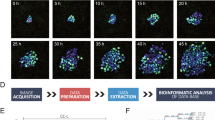Abstract
MUTATIONS at the steel (si) and dominant white spotting (W) loci in the mouse affect primordial germ cells (PGC), melanoblasts and haemopoietic stem cells1. The W gene encodes a cell-surface receptor of the tyrosine kinase family2,3, the proto-oncogene c-kit. In situ analysis has shown c-kitmessenger RNA expression in PGC in the early genital ridges4. The SI gene encodes the ligand for this receptor, a peptide growth factor, called here stem cell factor (SCF) 5–7. SCF mRNA is expressed in many regions of the early mouse embryo, including the areas of migration of these cell types8. It is important now to identify the role of the Sl-W interaction in the development of these migratory embryonic stem cell populations. Using an in vitro assay system9, we show that SCF increases both the overall numbers and colony sizes of migra-tory PGC isolated from wild-type mouse embryos, and cultured on irradiated feeder layers of STO cells (a mouse embryonic fibroblast line). In the absence of feeder cells, SCF causes a large increase in the initial survival and apparent motility of PGC in culture. But labelling with bromodeoxyuridine shows that SCF is not, by itself, a mitogen for PGC. SCF does not exert a chemotropic effect on PGC in in vitro assays. These results suggest that SCF in vivo is an essential requirement for PGC survival. This demon-strates the control of the early germ-line population by a specific trophic factor.
This is a preview of subscription content, access via your institution
Access options
Subscribe to this journal
Receive 51 print issues and online access
$199.00 per year
only $3.90 per issue
Buy this article
- Purchase on Springer Link
- Instant access to full article PDF
Prices may be subject to local taxes which are calculated during checkout
Similar content being viewed by others
References
Silvers, W. K. in The Coat Colours of Mice: a Model for Mammalian Gene Action and Interaction 243–267 (Springer, New York, 1979).
Chabot, B., Stephenson, D. A., Chapman, V. M., Besmer, P. & Bernstein, A. Nature 335, 88–89 (1988).
Geissler, E., Ryan, M. & Houseman, D. Cell 55, 185–192 (1988).
Orr-Urtreger, A. et al. Development 109, 911–923 (1990).
Zsebo, K. M. et al. Cell 63, 195–201 (1990).
Martin, F. H. et al. Cell 63, 203–211 (1990).
Zsebo, K. M. et al. Cell 63, 213–224 (1990).
Matsui, Y., Zsebo, K. M. & Hogan, B. L. M. Nature 347, 667–669 (1990).
Godin, I., Wylie, C. C. & Heasman, J. Development 108, 357–363 (1990).
Nocka, K., Buck, J., Levi, E. & Besmer, P. EMBO J. 9, 3287–99 (1990).
Anderson, D. et al. Cell 63, 235–243 (1990).
Dolci, S. et al. Nature 352, 809–811 (1991).
Dexter, T. M., Heyworth, C. M., Spooncer, E. & Ponting, I. L. Phil. Trans. R. Soc. B 327, 85–98 (1990).
Donovan, P., Stott, D., Caims, L. A., Heasman, J. & Wylie, C. C. Cell 44, 831–838 (1986).
Maniatis, T., Fritsch, E. & Sambrook, J. Molecular Cloning (Cold Spring Harbor Laboratory, New York, 1987).
Author information
Authors and Affiliations
Rights and permissions
About this article
Cite this article
Godin, I., Deed, R., Cooke, J. et al. Effects of the steel gene product on mouse primordial germ cells in culture. Nature 352, 807–809 (1991). https://doi.org/10.1038/352807a0
Received:
Accepted:
Issue Date:
DOI: https://doi.org/10.1038/352807a0
This article is cited by
-
Interaction of the primordial germ cell-specific protein C2EIP with PTCH2 directs differentiation of embryonic stem cells via HH signaling activation
Cell Death & Disease (2018)
-
Pluripotency and its layers of complexity
Cell Regeneration (2012)
-
Mechanisms guiding primordial germ cell migration: strategies from different organisms
Nature Reviews Molecular Cell Biology (2010)
-
c-Kit and stem cell factor regulate PANC-1 cell differentiation into insulin- and glucagon-producing cells
Laboratory Investigation (2010)
Comments
By submitting a comment you agree to abide by our Terms and Community Guidelines. If you find something abusive or that does not comply with our terms or guidelines please flag it as inappropriate.



